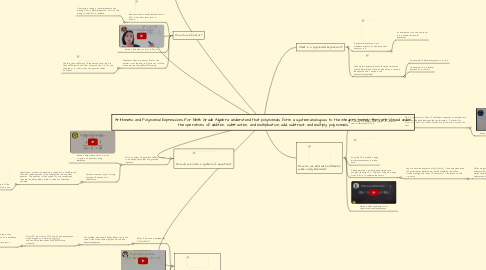
1. What is a polynomial expression?
1.1. A polynomial expression is an arithmetic expression with more than one term in it.
1.1.1. An expression with only one term in it is called a monomial expression.
1.2. The only two polynomials that have special names are the binomial and trinomial, which have 2 terms in the equation and 3 terms in the equation(respectively).
1.2.1. An example of binomial expression is 2x+3.
1.2.2. An example of a trinomial expression is 2x^2+x+3.
2. How do we deal with arithmetic when using binomials?
2.1. What if we have a problem like (x+2)(X-3)? The first thing we always need to think of when we see two binomials is FOIL.
2.1.1. FOIL is an acronym. Each of the letters represent a multiplication that should be done between the two binomials. F stands for First, O stands for Outside, I stands for Inside, and L stands for Last.
2.1.1.1. Here's a video example of FOIL in action.
2.2. Using the FOIL method, solving binomial expressions is made easy!
2.3. Adding binomials is actually quite simple once you get the hang of it. The first thing we always want to do is to combine like terms.
2.3.1. Say we have the expression (x-y)+(2x+3y). Take away because the parentheses because we just distribute by one(which wouldn't change the values of the terms). This leaves us with x-y+2x+3y.
2.3.1.1. After we get the equation without parentheses, we just add and subtract like terms. So to do that, we just group terms with similar variables. x+2x+3y-y. After this, the addition and subtraction is easy. 3x+2y. You just added two binomials!
2.4. Here's a video explaining how to subtract binomial expressions.
3. How do we deal with arithmetic in trinomial expressions.
3.1. What if we have a problem like (x-2)(x+1)(x+2)?
3.1.1. This problem may seem familiar, because we will solve it almost the same way that we solved a binomial expression.
3.1.1.1. First off, we want to FOIL two of the expressions, which will give us a binomial. [(x-2)(x+1)](x+2). We can do this because of the associative property.
3.1.1.1.1. This first FOIL will give us (x^2-x-2)(x+2). The next step is very easy to learn after learning FOIL. What we want to do is distribute x and 2 from (x+2) into (x^2-x-2). So we take x*x^2-x*x-2*x+2*x^2-2x-4. Combine like terms and we've got a polynomial expression!
3.2. Here's a little video explaining addition of two polynomial expressions.
3.3. Now you can easily add, subtract, and trinomial expressions! Learning these concepts will make algebra so much easier.
4. How do we factor?
4.1. Now that we've already learned how to FOIL, we need to learn how to factor.
4.1.1. Factoring is taking a trinomial equation and making it into a binomial equation. This is used mainly to solve for a variable.
4.2. Here's a little video on how to factor.
4.3. Sometimes when we have to factor, the answer won't be easy to figure out. In those cases we use the quadratic formula.
4.3.1. The B is the coefficient of the second term, the A is the coefficient of the first term, and the C is for the third term. In other words, the equation reads Ax^2+Bx+C.
5. How do we solve a system of equations?
5.1. First, a system of equations refers to two or more equations that are grouped together.
5.1.1. Here's a little video on how to solve a system of equations using elimination.
5.1.2. Another common way of solving systems of equations is substitution.
5.1.2.1. Substitution is when one equation is solved for a variable, and then that solved equation is the "substituted" into the other equation. The equation is then solved for the variable and then the solved variable is used to solve for the other variable.
5.1.2.1.1. Here's an example of the substitution method in use.
